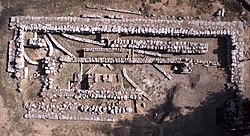![]() Click here to see the map of the area in full screen.
Click here to see the map of the area in full screen.
H Eretria and the Malakonta, Magoula are its settlements Of Evia.
Generally
THE Eretria is its coastal town Of Evia, south-east of Chalkida, opposite the north coast Attica, in the South Evia gulf.
History
The first confirmed organized settlement is placed in the period 3000-2000 BC. During the Late Bronze Age (1600-1100 BC) the settlement shrank and in the Geometric period was completely abandoned.
In antiquity it was one of the most important city-states of the Greek world (6th-5th century BC). In the 8th BC. century, Eretria and neighboring Chalkida, were the most prosperous cities of Evia. The Eretrians also established colonies in Southern Italy together with the Chalcidians. After the Battle of Chaeronia (338 BC), where Philip defeated the allied army of Athenians and Θηβαίων, also marked the final end of Eretria as an important city-state. The city still existed as a small provincial town. In 198 BC. was looted by the Romans and in 87 BC. it was destroyed during the Mithridatic Wars and eventually deserted.
The modern town was founded in 1824, after the outbreak of the Greek Revolution and the destruction of Psara in June 1824, when survivors from Psara came to the area, who named it Nea Psara.[1]. The name was used extensively in the 19th century (the constituency and the deputies were called "Neon Psara"), but then the name Eretria prevailed.
Tourist sites
How to get there
How to move
What to see


- Archaeological Museum of Eretria, ☎22290 62206. 08:30-15:00. The Museum of Eretria is one of the most important archaeological museums in Greece, which presents findings from various eras. Prominent in them are the sculptures of the temple of Daphne Apollo, and especially the complex of Theseus with the Amazon Antiope. The Museum is located in the immediate vicinity of the space, which helps to better understand it. The most important exhibits of the Museum can be considered the sculptural complex of Theseus with Antiope from the western gable of the temple of Daphne Apollo in Eretria, the clay statuette of Centaur from Lefkandi, which is the earliest representation of this mythological alogni with a printed representation from northern Syria and Panathenaic amphorae. In the lobby of the Museum are exhibited sculptures of the 4th c. e.g. and inscriptions, one of which is written in "bustrofidon". The first main room of the Museum includes the findings of prehistoric Eretria, as well as three neighboring prehistoric settlements, those of Xiropolis, Amarynthos and Magoula.
- Ancient theater of Eretria. The most impressive monument of ancient Eretria, one of the oldest known theaters, is located in the western part of the city, between the west gate, the stadium and the high school, the temple of Dionysus was located at the south-western end. As can be seen from the architectural monuments of the scene, the initial phase of construction took place after the Persian invasion and the reconstruction of the city, in the fifth century BC. A remarkable event is the construction of the amphitheater on an artificial hill surrounded by many walls support. During the first construction phase, the stage looked like a palace, had five consecutive rectangular rooms and was on the same level as the circular orchestra, with which it connected three entrances. At its peak (fourth century BC), the theater underwent transformations and was largely shaped in its current form. Local alabaster was used for the foundation and limestone in the corridors, with a slope towards the orchestra, in order to reduce the difference in height with the amphitheater. The theater had a capacity of 6,300 spectators and is reminiscent in form of the theater of Dionysus in Athens. After the destruction of Eretria by the Romans in 198 BC, it was rebuilt with lower quality materials and the rooms to the south of the aisle were decorated with colored mortars in the early Pompeian style. Unfortunately, most parts of the amphitheater have been looted. There are still the impressive ruins of the stage, mainly the vaulted underground passage that led to the center of the orchestra. The excavation of the monument was carried out by the American School of Archeology.
Entertainment
Events
What will you buy
Where to go for coffee - drink
Where are you going to eat?
Where will you stay?
Economic options
Middle class
High benefits
- Grand Bleu Sea Resort, ☎22290 61012, 60547, 61034. 3 * Hotel
Stay safe
Health and precautions
Communications
Small problems
Next destinations
[[Category:]]
- ↑Municipality of Eretria, Our history, retrieved December 4, 2010

